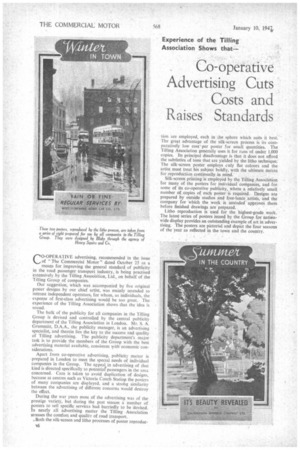Co-operative Advertising Cuts Costs and Raises Standards
Page 40

If you've noticed an error in this article please click here to report it so we can fix it.
These two posters. reproduced by the litho process, are taken from a series of eight prepared for use by all companies in the Tilling Group. They were designed by Blake through the agency of Henry Squire and Co, (-10-OPERATIVE advertising, recommended in the issue L. of "The Commercial Motor" dated October 25 as a
means for improving the general standard of publicity in the road passenger transport industry, is being practised extensively by the Tilling Association, Ltd., on behalf of the Tilling Group of companies: Our suggestion, which was accompanied by five original poster designs by our chief artist, was mainly intended to interest independent operators, for whom, as individuals, the expense of first-class advertising would be too great. The experience of the Tilling Association shows that the idea is sound.
The bulk of the publicity for all companies in the Tilling Group is devised and controlled by the central publicity department of the Tilling Association in I.ondon. Mr. S. A. Grurnmitt, D.A.A., the publicity manager, is an advertising specialist, and therein lies the key to the success and quality of Tilling advertising. The publicity department's major task is to provide the members of the Group with the best advertising material available, consistent With economic considerations.
Apart from co-operative advertising, publicity matter is prepared in London to meet the special needs of individual companies in the Group. The appeal in advertising of that kind is directed specifically to potentiar passengers in the area concerned. Care is taken to avoid duplication of designs, because at centres such as Victoria Coach Statiop the posters of many companies are displayed. and a strong similarity between the advertising of different concerns would destroy the effect.
During the war years most of the advertising was of the prestige variety, but during the past season a number of posters to sell specific services had hurriedly to be devised. In nearly all advertising matter the Tilling Association stresses the comfort and quality of road transport.
.Both the silk-screen and litho processes of poster reproduc lion are employed, each in ihe sphere which suits it best. The great advantage of the silk-screen process is its comparatively low cost' per poster for small quantities. The Tilling Association generally uses it for runs of under 1.000 copies. Its principal disadvantage is that it does not afford the subtleties of tone that are yielded by the litho technique. The silk-screen poster employs only flat colours and the artist must treat his subject boldly, with the ultimate means for reproduction continually in mind.
Silk-screen printing is employed by the Tilling Association for many of the posters for individual companies, and for some of its co-operative publicity, where a relatively small number of copies of each poster is required. Designs are prepared by outside studios and free-lance artists, and the company for which the work is intended approves them before finished drawings are prepared.
Litho reproduction is used for the highest-grade work. The latest series of posters issued by the Group for nationwide display provides an outstanding example of art in advertising. The posters are pictorial and depict the four seasons of the year as reflected in the town and the country.




















































































